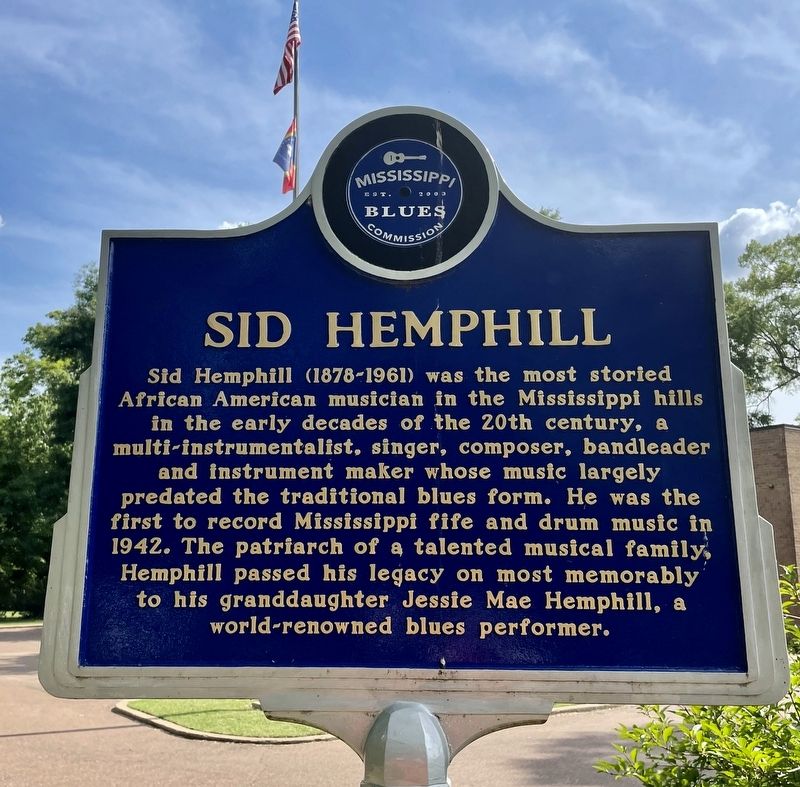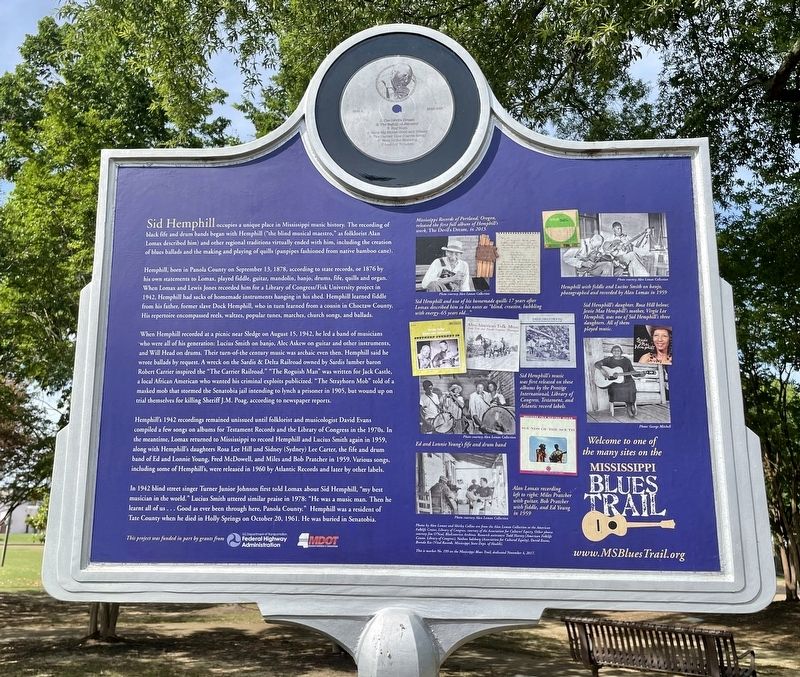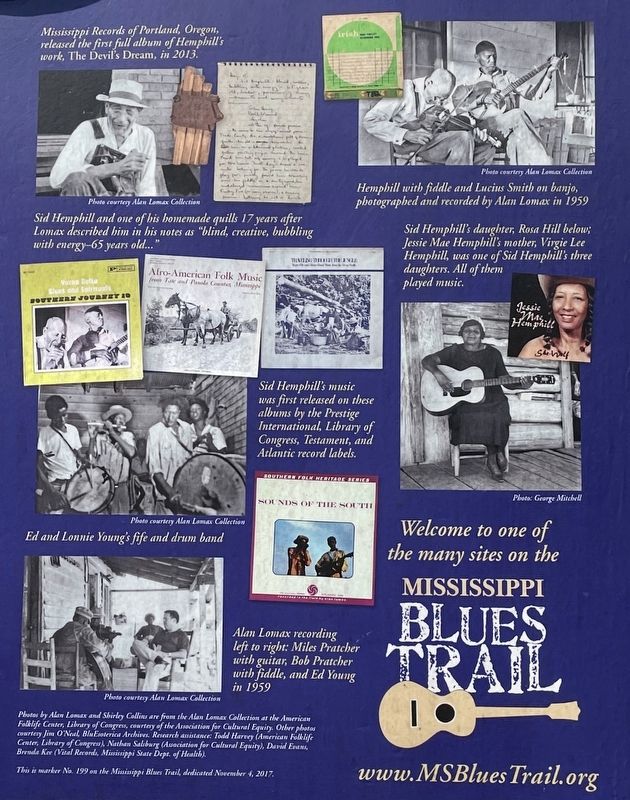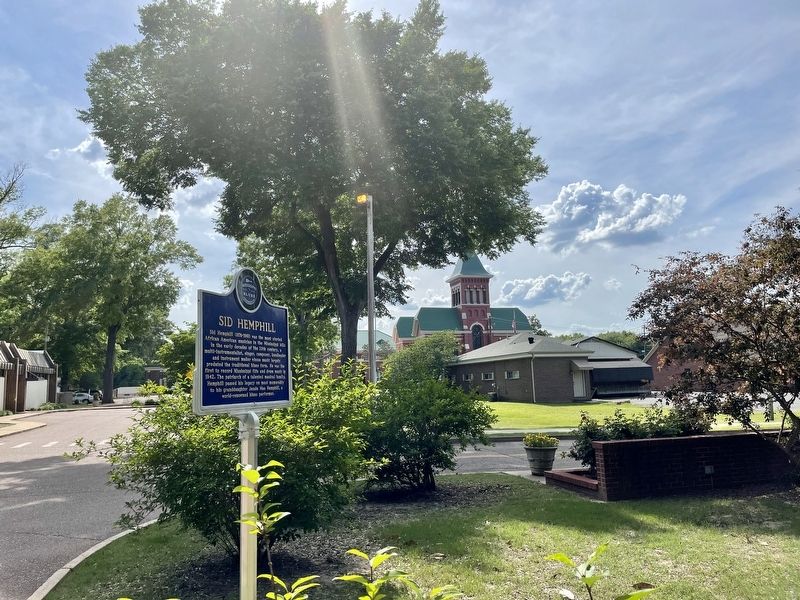Senatobia in Tate County, Mississippi — The American South (East South Central)
Sid Hemphill
— Mississippi Blues Trail —
Sid Hemphill occupies a unique place in Mississippi music history. The recording of black fife and drum bands began with Hemphill (“the blind musical maestro,” as folklorist Alan Lomax described him) and other regional traditions virtually ended with him, including the creation of blues ballads and the making and playing of quills (panpipes fashioned from native bamboo cane). Hemphill, born in Panola County on September 13, 1878, according to state records, or 1876 by his own statements to Lomax, played fiddle, guitar, mandolin, banjo, drums, fife, quills and organ. When Lomax and Lewis Jones recorded him for a Library of Congress/Fisk University project in 1942, Hemphill had sacks of homemade instruments hanging in his shed. Hemphill learned fiddle from his father, former slave Dock Hemphill, who in turn learned from a cousin in Choctaw County. His repertoire encompassed reels, waltzes, popular tunes, marches, church songs, and ballads.
When Hemphill recorded at a picnic near Sledge on August 15, 1942, he led a band of musicians who were all of his generation: Lucius Smith on banjo, Alec Askew on guitar and other instruments, and Will Head on drums. Their turn-of-the century music was archaic even then. Hemphill said he wrote ballads by request. A wreck on the Sardis & Delta Railroad owned by Sardis lumber baron Robert Carrier inspired the “The Carrier Railroad.” “The Roguish Man” was written for Jack Castle, a local African American who wanted his criminal exploits publicized. “The Strayhorn Mob” told of a masked mob that stormed the Senatobia jail intending to lynch a prisoner in 1905, but wound up on trial themselves for killing Sheriff J.M. Poag, according to newspaper reports.
Hemphill’s 1942 recordings remained unissued until folklorist and musicologist David Evans compiled a few songs on albums for Testament Records and the Library of Congress in the 1970s. In the meantime, Lomax returned to Mississippi to record Hemphill and Lucius Smith again in 1959, along with Hemphill’s daughters Rosa Lee Hill and Sidney (Sydney) Lee Carter, the fife and drum band of Ed and Lonnie Young, Fred McDowell, and Miles and Bob Pratcher in 1959. Various songs, including some of Hemphill’s, were released in 1960 by Atlantic Records and later by other labels.
In 1942 blind street singer Turner Junior Johnson first told Lomax about Sid Hemphill, “my best musician in the world.” Lucius Smith uttered similar praise in 1978: “He was a music man. Then he learnt all of us . . . Good as ever been through here, Panola County.” Hemphill was a resident of Tate County when he died in Holly Springs on October 20, 1961. He was buried in Senatobia.
Erected 2017 by the Mississippi Blues Commission. (Marker Number 199.)
Topics and series. This historical marker is listed in these topic lists: Arts, Letters, Music • Entertainment. In addition, it is included in the Mississippi Blues Trail series list. A significant historical date for this entry is August 15, 1942.
Location. 34° 37.006′ N, 89° 57.884′ W. Marker is in Senatobia, Mississippi, in Tate County. Marker is on Center Street south of West Tate Street, on the right when traveling north. Located behind the Senatobia Public Library in Gabbert Park. Touch for map. Marker is in this post office area: Senatobia MS 38668, United States of America. Touch for directions.
Other nearby markers. At least 8 other markers are within 8 miles of this marker, measured as the crow flies. O.B. McClinton (within shouting distance of this marker); Senatobia (about 800 feet away, measured in a direct line); Tate County World War I Memorial (approx. 0.4 miles away); Bethesda Cemetery (approx. 0.4 miles away); Jessie Mae Hemphill (approx. 1.6 miles away); Tate County Blues: Coldwater (approx. 5 miles away); Otha Turner (approx. 7.3 miles away); Mississippi Fred McDowell (approx. 7.3 miles away). Touch for a list and map of all markers in Senatobia.
Also see . . . Wikipedia article on Sid Hemphill. (Submitted on May 28, 2021, by Mark Hilton of Montgomery, Alabama.)
Credits. This page was last revised on July 31, 2023. It was originally submitted on May 28, 2021, by Mark Hilton of Montgomery, Alabama. This page has been viewed 206 times since then and 30 times this year. Photos: 1, 2, 3, 4. submitted on May 28, 2021, by Mark Hilton of Montgomery, Alabama.



